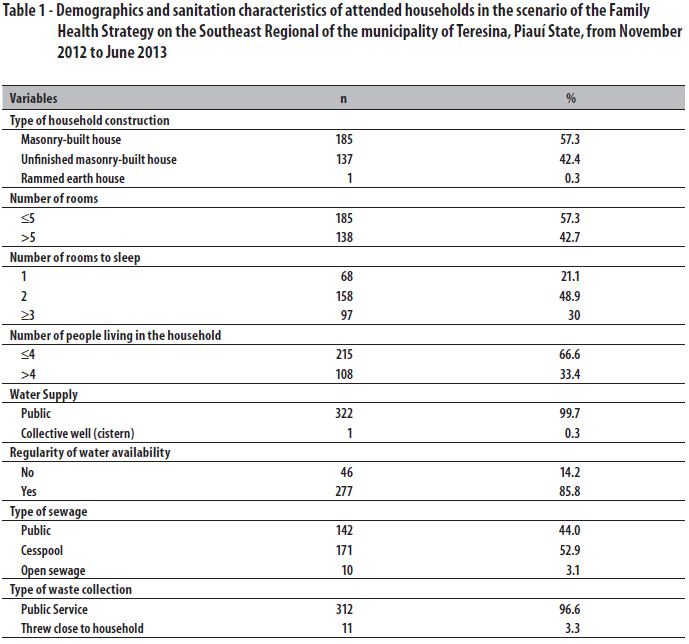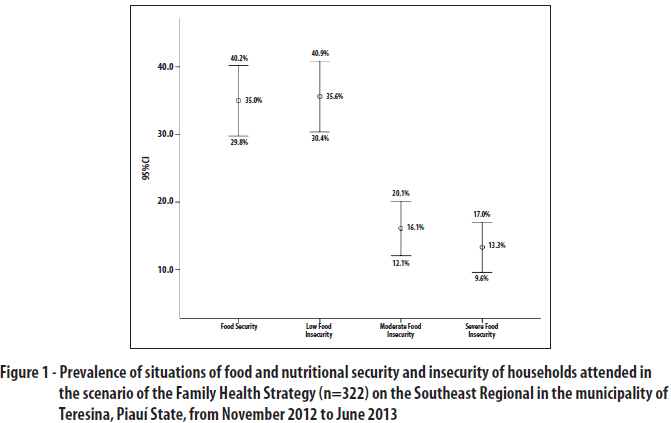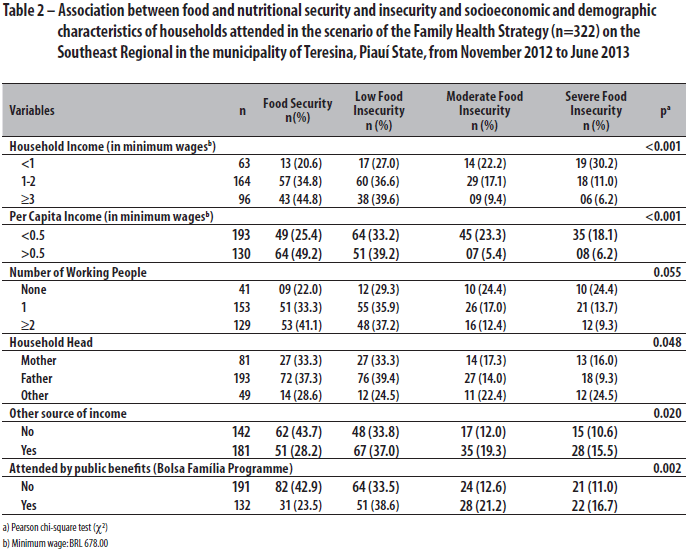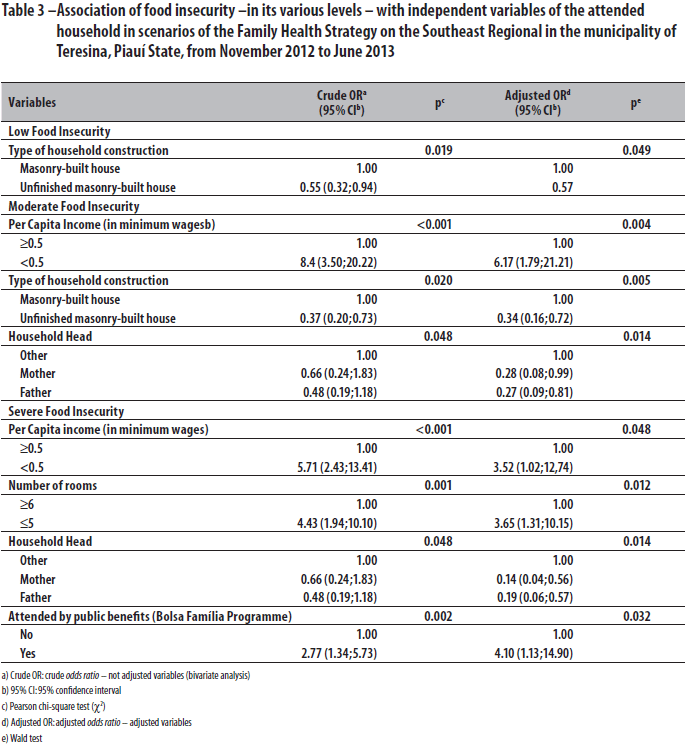Serviços Personalizados
Journal
Artigo
Indicadores
-
 Citado por SciELO
Citado por SciELO
Links relacionados
-
 Similares em
SciELO
Similares em
SciELO
Compartilhar
Epidemiologia e Serviços de Saúde
versão impressa ISSN 1679-4974versão On-line ISSN 2237-9622
Epidemiol. Serv. Saúde v.24 n.4 Brasília dez. 2015
http://dx.doi.org/10.5123/S1679-49742015000400017
ORIGINAL ARTICLE
Prevalence of food insecurity and associated factors in households covered by the Family Health Strategy in Teresina-PI, Brazil, 2012-2013*
Rocilda Cleide Bonfin de Sabóia1; Marize Melo dos Santos2
1Estácio CEUT, Curso de Nutrição,
Teresina-PI, Brasil
2Universidade Federal do Piauí,
Departamento de Nutrição, Teresina-PI, Brasil
ABSTRACT
OBJECTIVE: to analyze food insecurity
prevalence and associated factors with socioeconomic and demographic factors
among families assisted by the Family Health Strategy in Teresina-PI, Brazil.
METHODS: this was a cross-sectional study conducted in 2012-2013, with
323 families, whose heads answered the questionnaires.
RESULTS: the prevalence of low food insecurity was 35.6% low, 16.1% moderate
and 13.3% severe; association was found with (i) low food insecurity and masonry-built
houses (OR=0.57; 95%CI=0.32;0.99); (ii) moderate food insecurity and lower per
capita income (OR=6.17; 95%CI=1.79;21.21), masonry-built house (OR=0.34; 95%CI=0.16;0.72)
and the father not being the household head (OR=0.027; 95%CI=0.09;0.81); and
(iii) severe food insecurity and lower per capita income (OR=3.52; 95%CI=1.02;12.74),
household with greater number of rooms (OR=3.65; 95%CI=1.31;10.15), the father
not being the household head (OR=0.19; 95%CI=0.06;0.57) and being a beneficiary
of the income transfer Programme (OR=4.10; 95%CI=1.13; 14.90).
CONCLUSION: food insecurity prevalence was high and showed association
with socioeconomic and demographic factors.
Keywords: Cross-Sectional Studies; Food and Nutritional Security; Family Health Strategy; Family.
Introduction
Food insecurity is the concern and/or distress in face of the uncertainty of daily food availability; hunger or having a low quality diet, monotonous and insufficient to cover the basic needs of the individual.1
The consequences of this situation are directly related to the lack of quantity and quality diet, especially for the most vulnerable groups, which can contribute to infant mortality, harm to physical and mental development, low birth weight and maternal mortality.2
It is possible to verify the access to food by using a scale that indicates the status of food security or insecurity at a household: the Brazilian Food Insecurity Scale (EBIA), which allows diagnosis of food insecurity and has been used as a sensitive indicator to identify households at risk.23
Data from the 2009 National Household Sample Survey (PNAD) revealed that 34.8% of the Brazilian population had some degree of food insecurity, demonstrating an important public health issue.4
According to the first national diagnosis of food insecurity, conducted in 2004, about 40% of Brazilians lived with some degree of food insecurity, distributed as follows: 18% of low food insecurity, 14.1% of moderate food insecurity and 7.7% of severe food insecurity.4 In 2009, another survey showed that nearly 70% of all the country's households were in food security condition, a better result than the one presented in the 2004 PNAD.4
The issue of food security in Brazil is relevant for social inclusion policies to improve the quality of life, as well as the Family Health Strategy (ESF). The ESF is recognized as a family health care model and respects the principles of the National Health System (SUS). Both food security and family health care must be synchronized and mutually improved; intervening on the determinants of health problems to which the population is exposed.5
So far, there is no knowledge of studies on the Brazilian municipality of Teresina that reflect the situation of food security of the resident population in the suburbs of this municipality, as well as the factors associated with it. The objective of this study was to identify food insecurity prevalence and its association with socioeconomic and demographic factors among families assisted by the Family Health Strategy in the suburbs of Teresina, Piauí State (PI), Brazil.
Methods
A cross-sectional study was conducted on the situation of the population's food and nutrition insecurity in the suburbs of Teresina-PI, from November 2012 to June 2013.
The research was conducted with low socioeconomic class household residents in the districts of Frei Damião and Alto da Ressurreição, assisted by the ESF of Teresina's Southeast Regional. These neighborhoods are assisted by public programs of health and education; their streets are paved and are assisted by public transportation. All households have sanitation and regular waste collection. There were 3,692 families living in the areas covered by the survey, according to data obtained from the records provided by the ESF local teams. Both districts had a Family Health Unit, composed of four ESF teams, whose activities are distributed in 24 micro areas of expertise.
The sample calculation considered the prevalence of 30%4 of food insecurity, according to PNAD 20094, margin of error of 5 percentage points and 95% confidence interval, resulting in a sample size of 322 households. There were no extra households in case of losses or refusals. Closed households were replaced. The study included families living in the asset register of households in the ESF and who lived in the neighborhoods of the Southeast Regional coverage area. The selection was probabilistic; the household was the sample unit, which was randomly selected by the Biostat 3.0 program, by picking random numbers. In micro areas, the households attended by the ESF were surveyed until it completed the sample size, complying with the streets' order.
In each chosen micro area, addresses that composed it were identified, always starting the data collection with the first household of the first street of each micro area, followed by the next ones on an ascending order: after checking the first household to be visited, the interviewers were told to skip two household and visit the third one. If the interviewers found the household closed, they would return twice more, on subsequent days; if they were not successful again, they would head to another household, following the same systematic sequence.
The two instruments used to collecting data - the EBIA questionnaire and socioeconomic and demographic questionnaire with 11 questions related to socioeconomic and demographic issues - were applied within the household, answered by the household head. Visits to collect data lasted on average 30 minutes and were conducted by a team of interviewers composed of 24 Nutrition students of the Federal University of Piauí, previously trained by the researchers. A pilot study was conducted by applying the instrument on a sub-sample consisting of 120 households' heads living in the same neighborhoods on the Southeast Regional, non-sampled.
The independent variables were categorized for better analysis, as seen below:
- household income, based on the minimum wage (MW), equivalent to BRL 678.00 at the time of the research (<1 MW, 1-2 MW and ≥ 3 SM);
- income per capita(<1/2 MW and ≥ 1/2 MW);
- type of sewage (public and others);
- household head (mother, father and others);
- other source of income (beneficiary or not of Bolsa Família Programme);
- type of household construction (masonry-built house, unfinished masonry-built house, wood construction and rammed-earth house);
- number of rooms (open answers);
- number of rooms to sleep (open answers);
- water supply (public, well [cistern] in the household, collective well [cistern], another source); and
- water supply regularity (yes or no). The dependent variables were:
a. food security, evaluated by the EBIA, identified from 14 closed central questions, with yes or no answers, on the experience in the past three months of food insufficiency in its various levels of intensity, from the concern that the food would not be enough to the experience of spending an entire day without eating.
b. food insecurity, identified by the state of hunger experienced in the household: low, when they still did not experience hunger but already handle strategies to not affect the quality of the diet; moderate, when the adult members of the household have already had a quantitative restriction on the diet; and severe, when adults and children have experienced a state of hunger.6
The EBIA classifies the household under food security (FS) situation or food insecurity (FI) and their levels respectively for people under the age of 18 and over the age of 18, establishing the following score ranges: low (LFI: 1-5 and 1-3), moderate (MFI: 6-9 and 4-5); or severe (SFI: 10-14 and 8-8). A point for each positive response is assigned for building the score. The Statistical Package for Social Sciences (SPSS) software version 21.0 was used for data insertion and analysis. Double typing of data was carried out to avoid possible typos and to ensure its quality. A quality control of data collection was not carried out by reapplying the questionnaire on a sub-sample of the households surveyed. However, the internal consistency of responses to EBIA items was analyzed using Cronbach's alpha coefficient: values above 0.7 were considered satisfactory for the study. This statistical procedure indicated correlation among the answers.
The descriptive analysis was based on the average and standard deviation of the quantitative variables and proportions and 95% confidence intervals (95%CI) for categorical variables.
In the bivariate analysis, the association between EBIA scores and demographic characteristics and sanitation was found using Pearson's chi-square test (x2).
Multivariate analysis, performed using regression multinomial logistics, obtained estimates of odds ratios (OR) and 95% CI (Woolf's method), adjusted for confounding variables.7 Food security scores (reference category) were compared to low, moderate and severe food insecurity. The criterion for inclusion of variables in the logistic model was the association with the EBIA scores at p<0.20 in bivariate analysis.8 These variables were introduced according to the value of p in the bivariate analysis, from the smallest value to the greatest. The criterion of permanence of variables in the model was the association at the level of p<0.05.
The study was submitted to the Research Ethics Committee of the Federal University of Piauí, under the Certificate for Ethics Assessment (CAAE) No 12144013.30000. The Ethics Committee of the Municipal Health Foundation considered and approved the research in the Household Health Unit of the Southeast Regional, via Memorandum CAA No.0011/2013. Individuals who agreed to participate signed the Terms of Consent (prepared in accordance with the Declaration of Helsinki III, Chapter 50, paragraphs 50.20/27) as recommended by the Brazilian Health Council (CNS) No 466, dated December 12, 2012.
Results
In this study 323 households were evaluated. No household head refused to participate. However, 7 households (2.2%) were replaced since they were closed after being visited - even twice more in subsequent days.
Most visited households were masonry-built houses (57.3%), having up to 5 rooms. 66.6% of households had up to 4 residents. Virtually all houses had public system water supply and waste collection. Less than half (44.0%), however, were connected to sewage from the public sanitation (Table 1).

According to severity levels, food insecurity prevalence found in the households visited were 35.6% low (95%CI: 40.9;30.4), 16.1% moderate (95%CI: 20.1;12.1) and 13.3% severe (95%CI: 17.0;9.6) (Figure 1).

Food insecurity was associated to the household per capita income. The higher frequency of severe food insecurity (30.2%) was associated to the household income lower than 1 MW, whilst for those receiving less than ½ MW per capita, this condition was associated with low food insecurity (33,2%). For those who received more than 3 MW, there was a higher proportion of food security (44.8%) (p<0.001). A higher frequency of low food insecurity was observed in households that relied on the father as the main provider (39.4%) and among those registered on the Bolsa Família Programme (38.6%), when compared the frequency of moderate and severe food insecurity (Table 2).

Families living in masonry-built houses, when compared to those living in unfinished masonry-built houses, had 43% less chance of low food insecurity (OR=0.57; 95%CI:0.32;0.99). Families receiving less than half minimum wage had chances of moderate food insecurity 6.17 times greater (OR=6.17; 95%CI: 1.79;21.21). Households with up to 5 rooms had 3.6 times greater risk of severe food insecurity (OR=3.65; 95%CI:1.31;10.15). Beneficiaries of the Bolsa Família Programme, compared to those not receiving the benefit, had 4.10 times greater chance of severe food insecurity (OR=4.10; 95%CI:1.13;14.90) (Table 3).

Discussion
The outcomes analysis revealed that the surveyed families had high food insecurity condition associated with socioeconomic and demographic variables, such as type of household construction, greater number of rooms, lower per capita income, the household head not being the lather and being beneficiary of the Bolsa Família Programme.
According to the National Sanitation Information System (SNIS)9 data, in 2011, the state of Piauí showed an average rate of more than 90% of urban service for water supply; on the other hand, it also presented average rate of less than 10% of both urban service for sewage collection and sewage treatment, different values from the ones found in the sample analyzed here.
The national average of service for general population, identified by the SNIS in 2011,9 was 82.4% for water supply and 48.1% for sewage collection. As for the urban population, the SNIS data showed high compliance with water supply services: a national average proportion of 93.0%, whist for sewage collection, this proportion was of 55.5%.
The health profile of the selected households can be considered satisfactory: public water supply and regularity in its availability; sanitation by septic wells; and high coverage of frequent waste collection, also by public services. In July 2010, the United Nations (UN) defined the access to water and sanitation as an essential human right, although in the world the scenario of that time, 2.6 billion people did not have sewage collection and treatment and 900 million did not have access to sources of drinking water. When living in inadequate sanitation, people are exposed to a risk of worsening their health.10
The 2009 National Household Sample Survey showed a prevalence of 30.2% of food insecurity in Brazil, where the state of Piauí was the second among the Federal Units: 58.7% of food insecurity, being 36.0% of low food insecurity, 12.9% moderate and 9.7% severe.11 By addressing one of the four Regionals of Teresina-PI, this study showed, however, higher prevalence: 65.0% of food insecurity, being 35.6% of low food insecurity, 16.1% moderate and 13.3% severe. This may be the scenario of the municipality's situation when the focus of the analysis is restricted to households in the suburbs of the capital, where such prevalence rates are higher than those of the state for the moderate and severe levels. However, the variable 'food insecurity' behavior has shown similarities among the Brazilian macro-regions, revealing high prevalence of this inequity indicator in the South, North and Northeast Regions.12-14
The high prevalence of food insecurity found can be seen in the concern of the heads of families related to access, quality and quantity of food intake at home, determined by unfavorable conditions to its acquisition demonstrated in the results of this work.
These conditions are directly related to insufficient income for food expenses: households with income below 1 minimum wage had a higher prevalence of moderate and severe food insecurity. The Household Budget Survey (POF) 2008-2009 presented the value of 5.5 minimum wages as an estimated total of the monthly average expenditure of households in Brazil, whilst the same corresponding estimate for the Northeast Region was 3.5 minimum wages, below the assigned to other macro-regions.15
With regard to the analysis of PNAD data presented for the years 2004 and 2009, Hoffmann16 observed a sharp increase of income, mainly from relatively poor households, and it is possible to associate this fact to a decrease in the prevalence of food insecurity -moderate and severein this period.16
A population survey showed that households in food security situation consume fruit (73.7%) and dairy products (62.1%) at least once a day, while for those in situations of food insecurity, the consumption of these foods appears to a smaller proportion of households - respectively 11.4% and 5.5%, with moderate and severe food insecurity.17
The association between food insecurity and being attended by the Bolsa Família Programme is related to the socioeconomic vulnerability of the beneficiaries, as other studies have found.3,18-20
The exposure of families to a situation of vulnerability related to living conditions, in turn, increases the chances of food insecurity: not living in masonry-built houses increases by almost twice the chance of food insecurity.18 Moreover, residents of unfinished and poor masonry-built houses present (i) chance 3.5 times higher of moderate and severe food insecurity and (ii) chance 2.9 times higher of low food insecurity, compared to those living in masonry-builthouses.20
Female-headed households were more likely to present food insecurity, which can be explained by women's situation in the labor market. Among the households studied there was a greater proportion of men as household heads (the main provider), a finding possibly associated with higher economic value of men's work - which is clear both in the salary received and in the occupation of the most prestigious positions - and with the traditional role of women as children's and house carers, leading to their staying at home and discouraging their integration into the labor market: the likely lower wages and positions for women would not outweigh the temporary abandonment of the home and children. However, the number of female-headed households has changed the socioeconomic profile of the family unit: according to this study, in many cases, the woman was solely responsible for the household's income. This situation could be observed in the Brazilian Northeast and South Regions, where the highest probability of moderate and severe food insecurity corresponded with households headed by women.21
It is necessary to point out some limitations encountered in the development of this study, for example, regarding the income information - especially when low - often given with some embarrassment of the respondent, which could influence the collection and quality of information. Another aspect of difficulty for this research is related to the fear that some families had to respond to the questions, fearing that this would be a government investigation into their conditions for maintaining the benefit of the Bolsa Família Programme. However, as they understood the goals and the importance of the survey, respondents felt safer to participate. A final limitation to consider refers to the cross-sectional design of the study and its inability to reveal the temporality of associations.
The prevalence of food insecurity was identified in most of the surveyed households and was associated to the type of household construction, the greater number of rooms, lower per capita income, the father not being the household head, and being a beneficiary of the Bolsa Família Programme. From this perspective, this study should contribute to the knowledge of the food security and insecurity situation of the households attended by the Southeast Regional ESF of Teresina, Piauí State. It is believed that the results presented here -besides meaning new inputs - will envision new strategies for the design of more effective public policies to prevent and combat hunger. In this sense, the existence of a popular restaurant in Teresina-PI is an initiative model, allowing access of the population with less purchasing power to a balanced and healthy diet.
However, mechanisms should be developed with the aim of improving the household purchasing power, such as offering greater opportunities for professional training, facilitating the entry in the labor market of this population, in addition to stimulating the production of home vegetable gardens and access to nutritional education, targeting the reduction or eradication of food insecurity, especially in its moderate and severe forms.
Authors' contributions
Santos MM participated in the conception and design of the study, critical review of the manuscript's intellectual content and final approval of the version to be published.
Saboia RCB participated in the data's collection, analysis and interpretation; drafting of the manuscript's intellectual content and the final approval of the version to be published.
Both authors are responsible for all aspects of the work, ensuring its accuracy and integrity.
References
1. Marin-Leon L, Segall-Correa AM, Panigassi G, Maranha LK, Sampaio MAA, Pérez-Escamila R. A percepção de insegurança alimentar em famílias com idosos em Campinas, São Paulo, Brasil. Cad Saude Publica. 2005 set-out;21(5):1433-40.
2. Salles-Costa R, Pereira RA, Vasconcellos MTL, Veiga GV, Marins VMR, Jardim BC. Associação entre fatores socioeconômicos e insegurança alimentar: estudo de base populacional na Região Metropolitana do Rio de Janeiro, Brasil. Rev Nutr. 2008 jul-ago;21 supl:99-109.
3. Segall-Correa AM, Marín-Leon L, Helito H, Péres-Escamila R, Santos LMP, Paes-Sousa R. Transferência de renda e segurança alimentar no Brasil: análise dos dados nacionais. Rev Nutr. 2008 jul-ago;21 supl:39-51.
4. Instituto Brasileiro de Geografia e Estatística. Pesquisa Nacional por Amostras de Domicílio: segurança alimentar 2004/2009[Internet]. Rio de Janeiro: IBGE; 2010[citado 2011 ago 25]. Disponível em: http://www.ibge.gov.br/home/estatistica/populacao/seguranca_alimentar_2004_2009/pnadalimentar.pdf
5. Ministério da Saúde (BR). Secretaria de Assistência à Saúde. Coordenação de Saúde da Comunidade. Saúde da Família: uma estratégia para a reorientação do modelo assistencial [Internet]. Brasília: Ministério da Saúde; 1997 [citado 2012 ago 25]. Disponível em: http://bvsms.saude.gov.br/bvs/publicacoes/cd09_16.pdf
6. Universidade Estadual de Campinas. Relatório técnico. Acompanhamento e avaliação da segurança alimentar de famílias brasileiras: validação de metodologia e de instrumento de coleta de informação [Internet]. Campinas: Unicamp; 2003 [citado 2012 ago 10]. Disponível em: http://livros01.livrosgratis.com.br/op000013.pdf
7. Hamilton LC. Interpreting multinomial logistic regression. Stata Tech Bull. 1993;13:24-28.
8. Hosmer DW, Lemeshow S. Applied logistic regression. 2. ed. New York: John Wiley & Sons; 2000.
9. Ministério da Saúde (BR). Portal da Saúde [Internet]. Brasília: Ministério da Saúde; 2011 [citado 2011 ago 25]. Disponível em: http://portal.saude.gov.br/portal/saude/profissional/visualizar_texto.cfm?idtxt=32566
10. Instituto Trata Brasil. Esgotamento sanitário inadequado e impacto na saúde da população. Um diagnóstico da situação nos 81 municípios Brasileiros com mais de 300 mil habitantes [Internet]. [citado 2014 mar 11]. Disponível em: http://www.tratabrasil.org.br/novo_site/cms/templates/trata_brasil/files/esgotamento.pdf
11. Instituto Brasileiro de Geografia e Estatística. Pesquisa Nacional de Amostra por Domicilio: segurança alimentar. Rio de Janeiro: IBGE; 2010.
12. Anschau FR, Matsuo T, Segall-Correa AM. Insegurança alimentar entre beneficiários de programas de transferência de renda. Rev Nutr. 2012 mar-abr;25(2):177-89.
13. Guerra LDS, Espinoza MM, Bezerra ACD, Guimarães LV, Lima-Lopes MA. Insegurança alimentar em domicílios com adolescentes da Amazônia Legal Brasileira: prevalência e fatores associados. Cad Saude Publica. 2013 fev;29(2):335-48.
14. Aires JS, Martins MC, Joventino ES, Ximenes LB. (In) Segurança alimentar em famílias de pré-escolares de uma zona rural do Ceará. Acta Paul Enferm. 2012;25(1):102-8.
15. Instituto Brasileiro de Geografia e Estatística . Pesquisas de Orçamentos Familiares (POF) 2008-2009: despesas, rendimentos e condições de vida. Rio de Janeiro: IBGE; 2010.
16. Hoffmann R. Determinantes da insegurança alimentar no Brasil em 2004 e 2009. Seg Alim Nutr. 2013;20(2):219-35.
17. Panigassi G, Segall-Correa AM, Marín-Leon L, Pérez-Escamila R, Sampaio MFA, Maranha LK. Insegurança alimentar como indicador de iniqüidade: análise de inquérito populacional. Cad Saude Publica. 2008 out;24(10):2376-84.
18. Vianna RPT, Segall-Correa AM. Insegurança alimentar das famílias residentes em municípios do interior do estado da Paraíba, Brasil. Rev Nutr. 2008 jul-ago;21 supl:111-22.
19. Souza NNS, Dias MM, Sperandio N, Franceschini SCC, Priore SE. Perfil socioeconômico e insegurança alimentar e nutricional de famílias beneficiárias do Programa Bolsa Família no município de Viçosa, Estado de Minas Gerais, Brasil, em 2011: um estudo epidemiológico transversal. Epidemiol Serv Saude. 2012 dez;21(4):655-62
20. Peixoto MRG, Ramos K, Martins KA, Schincaglia RM, Braudes-Silva LA. Insegurança alimentar na área de abrangência do Núcleo de Apoio à Saúde da Família em Itumbiara, Goiás. Epidemiol Serv Saude. 2014 jun;23(2):327-36.
21. Facchini LA, Nunes BP, Mota JVS, Tomasi E, Silva SM, Thumé E, et al. Insegurança alimentar no Nordeste e Sul do Brasil: magnitude, fatores associados e padrões de renda per capita para redução das iniquidades. Cad Saude Publica. 2014 jan;30(1):161-74.
 Correspondence:
Correspondence:
Marize Melo dos Santos
Av. Senador Arêa Leão, no 2600,
apto. 202, Jóquei
Teresina-PI, Brasil.
CEP: 64049-110.
E-mail: marizesantos@ufpi.edu.br
Received on 02/11/2014
Approved on 25/02/2015
* Article originated from Rocilda Cleide Bonfin de Saboia's Master's dissertation defended at the Post-Graduate Studies in Food and Nutrition Program from the Federal University of Piauí, in May 2014.











 texto em
texto em 

